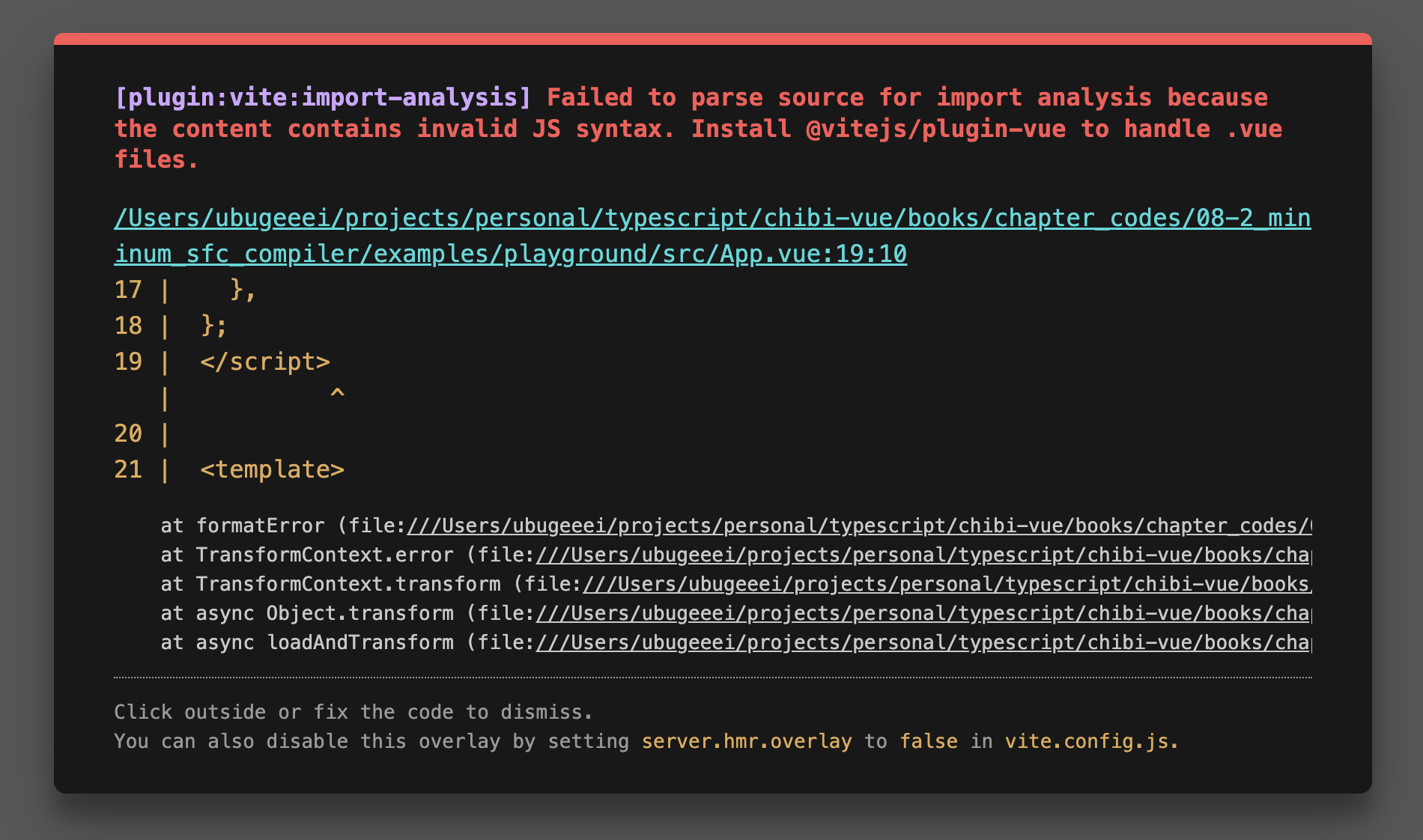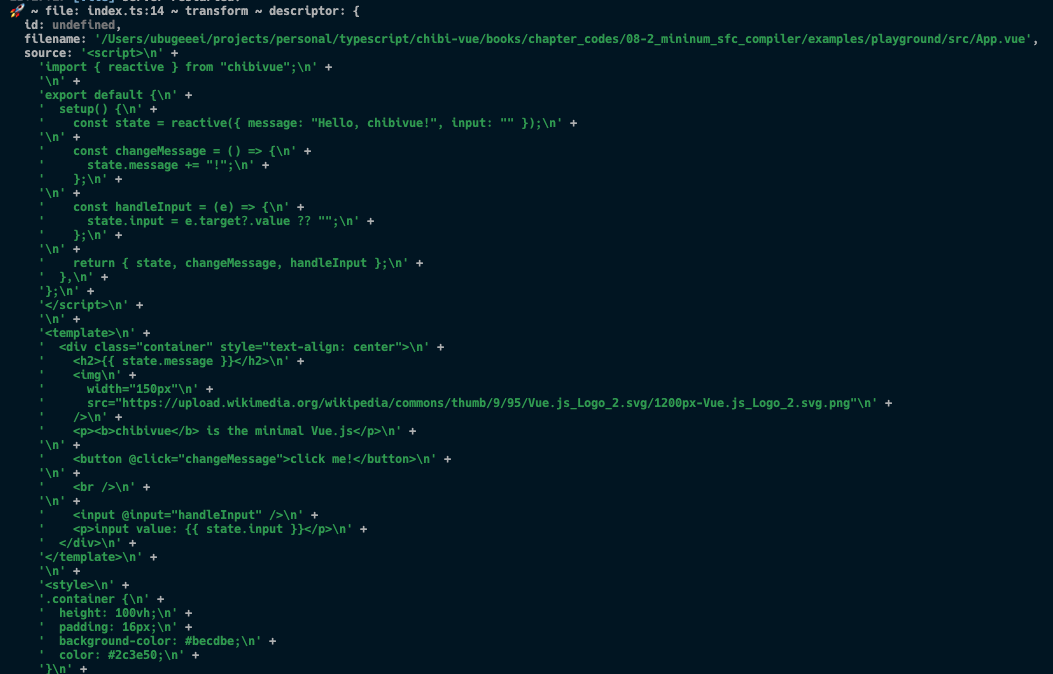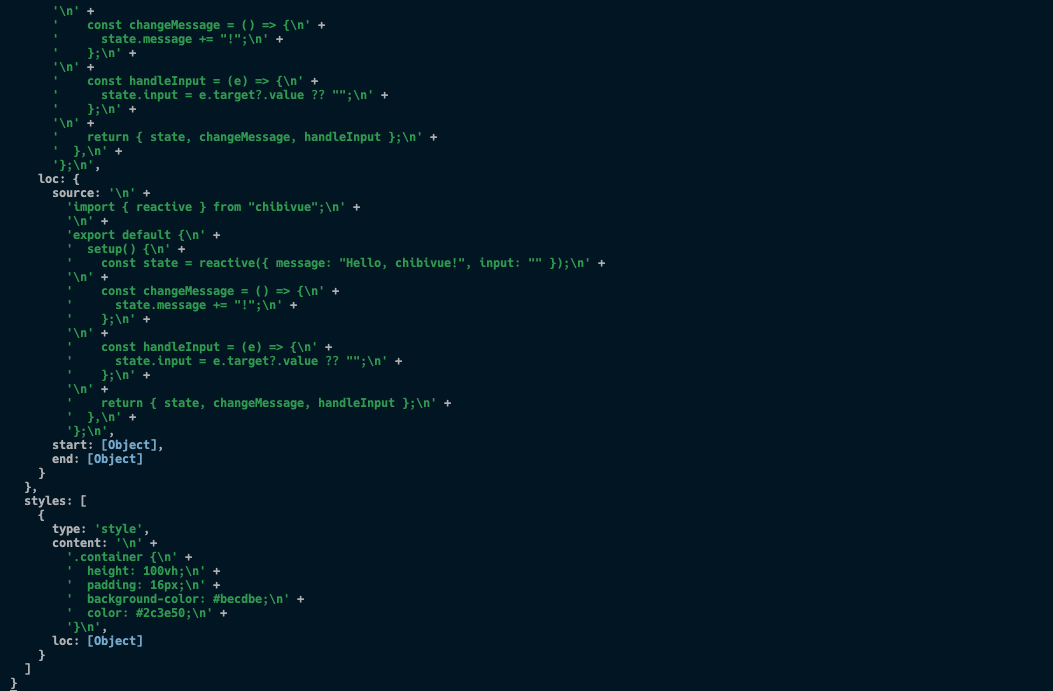實現 SFC 解析器
準備工作
雖然這是我們之前創建的範例外掛程式,但讓我們刪除它,因為它不再需要了.
pwd # ~
rm -rf ./plugin-sample另外,為了創建 Vite 外掛程式,請安裝主要的 Vite 套件.
pwd # ~
ni vite這是外掛程式的主要部分,但由於這原本超出了 vuejs/core 的範圍,我們將在 packages 目錄中創建一個名為 @extensions 的目錄並在那裡實現它.
pwd # ~
mkdir -p packages/@extensions/vite-plugin-chibivue
touch packages/@extensions/vite-plugin-chibivue/index.ts~/packages/@extensions/vite-plugin-chibivue/index.ts
import type { Plugin } from 'vite'
export default function vitePluginChibivue(): Plugin {
return {
name: 'vite:chibivue',
transform(code, id) {
return { code }
},
}
}現在,讓我們實現 SFC 編譯器.
但是,沒有任何實質內容可能很難想像,所以讓我們實現一個遊樂場並在執行時進行.
我們將創建一個簡單的 SFC 並載入它.
pwd # ~
touch examples/playground/src/App.vueexamples/playground/src/App.vue
<script>
import { reactive } from 'chibivue'
export default {
setup() {
const state = reactive({ message: 'Hello, chibivue!', input: '' })
const changeMessage = () => {
state.message += '!'
}
const handleInput = e => {
state.input = e.target?.value ?? ''
}
return { state, changeMessage, handleInput }
},
}
</script>
<template>
<div class="container" style="text-align: center">
<h2>{{ state.message }}</h2>
<img
width="150px"
src="https://upload.wikimedia.org/wikipedia/commons/thumb/9/95/Vue.js_Logo_2.svg/1200px-Vue.js_Logo_2.svg.png"
alt="Vue.js Logo"
/>
<p><b>chibivue</b> is the minimal Vue.js</p>
<button @click="changeMessage">click me!</button>
<br />
<label>
Input Data
<input @input="handleInput" />
</label>
<p>input value: {{ state.input }}</p>
</div>
</template>
<style>
.container {
height: 100vh;
padding: 16px;
background-color: #becdbe;
color: #2c3e50;
}
</style>playground/src/main.ts
import { createApp } from 'chibivue'
import App from './App.vue'
const app = createApp(App)
app.mount('#app')playground/vite.config.js
import path from 'node:path'
import { fileURLToPath } from 'node:url'
import { defineConfig } from 'vite'
import chibivue from '../../packages/@extensions/vite-plugin-chibivue'
const dirname = path.dirname(fileURLToPath(new URL(import.meta.url)))
export default defineConfig({
resolve: {
alias: {
chibivue: path.resolve(dirname, '../../packages'),
},
},
plugins: [chibivue()],
})讓我們嘗試在這種狀態下啟動.

當然,這會導致錯誤.做得好(?).
解決錯誤
讓我們暫時解決錯誤.我們不會立即追求完美.
首先,讓我們將 transform 的目標限制為 "*.vue".
我們可以像在範例中那樣使用 id 編寫分支語句,但由於 Vite 提供了一個名為 createFilter 的函式,讓我們使用它創建一個過濾器.
(這沒有特別的原因.)
~/packages/@extensions/vite-plugin-chibivue/index.ts
import type { Plugin } from 'vite'
import { createFilter } from 'vite'
export default function vitePluginChibivue(): Plugin {
const filter = createFilter(/\.vue$/)
return {
name: 'vite:chibivue',
transform(code, id) {
if (!filter(id)) return
return { code: `export default {}` }
},
}
}我們創建了一個過濾器,如果是 Vue 檔案,則將檔案內容轉換為 export default {}.
錯誤應該消失,螢幕應該不顯示任何內容.
在 compiler-sfc 上實現解析器
現在,這只是一個臨時解決方案,所以讓我們實現一個合適的解決方案.
vite-plugin 的作用是使用 Vite 啟用轉換,所以解析和編譯在主 Vue 套件中.
那就是 compiler-sfc 目錄.
https://github.com/vuejs/core/blob/main/.github/contributing.md#package-dependencies
SFC 編譯器對於 Vite 和 Webpack 都是相同的.
核心實現在 compiler-sfc 中.
讓我們創建 compiler-sfc.
pwd # ~
mkdir packages/compiler-sfc
touch packages/compiler-sfc/index.ts在 SFC 編譯中,SFC 由一個名為 SFCDescriptor 的物件表示.
touch packages/compiler-sfc/parse.tspackages/compiler-sfc/parse.ts
import { SourceLocation } from '../compiler-core'
export interface SFCDescriptor {
id: string
filename: string
source: string
template: SFCTemplateBlock | null
script: SFCScriptBlock | null
styles: SFCStyleBlock[]
}
export interface SFCBlock {
type: string
content: string
loc: SourceLocation
}
export interface SFCTemplateBlock extends SFCBlock {
type: 'template'
}
export interface SFCScriptBlock extends SFCBlock {
type: 'script'
}
export declare interface SFCStyleBlock extends SFCBlock {
type: 'style'
}嗯,沒有什麼特別困難的.
它只是一個表示 SFC 資訊的物件.
在 packages/compiler-sfc/parse.ts 中,我們將把 SFC 檔案(字串)解析為 SFCDescriptor.
你們中的一些人可能在想,「什麼?你在模板解析器上如此努力工作,現在你要創建另一個解析器...?這很麻煩.」但不要擔心.
我們在這裡要實現的解析器並不是什麼大事.那是因為我們只是通過結合我們迄今為止創建的內容來分離模板,腳本和樣式.
首先,作為準備,匯出我們之前創建的模板解析器.
~/packages/compiler-dom/index.ts
import { baseCompile, baseParse } from '../compiler-core'
export function compile(template: string) {
return baseCompile(template)
}
// 匯出解析器
export function parse(template: string) {
return baseParse(template)
}在 compiler-sfc 端保留這些介面.
pwd # ~
touch packages/compiler-sfc/compileTemplate.ts~/packages/compiler-sfc/compileTemplate.ts
import { TemplateChildNode } from '../compiler-core'
export interface TemplateCompiler {
compile(template: string): string
parse(template: string): { children: TemplateChildNode[] }
}然後,只需實現解析器.
packages/compiler-sfc/parse.ts
import { ElementNode, NodeTypes, SourceLocation } from '../compiler-core'
import * as CompilerDOM from '../compiler-dom'
import { TemplateCompiler } from './compileTemplate'
export interface SFCParseOptions {
filename?: string
sourceRoot?: string
compiler?: TemplateCompiler
}
export interface SFCParseResult {
descriptor: SFCDescriptor
}
export const DEFAULT_FILENAME = 'anonymous.vue'
export function parse(
source: string,
{ filename = DEFAULT_FILENAME, compiler = CompilerDOM }: SFCParseOptions = {},
): SFCParseResult {
const descriptor: SFCDescriptor = {
id: undefined!,
filename,
source,
template: null,
script: null,
styles: [],
}
const ast = compiler.parse(source)
ast.children.forEach(node => {
if (node.type !== NodeTypes.ELEMENT) return
switch (node.tag) {
case 'template': {
descriptor.template = createBlock(node, source) as SFCTemplateBlock
break
}
case 'script': {
const scriptBlock = createBlock(node, source) as SFCScriptBlock
descriptor.script = scriptBlock
break
}
case 'style': {
descriptor.styles.push(createBlock(node, source) as SFCStyleBlock)
break
}
default: {
break
}
}
})
return { descriptor }
}
function createBlock(node: ElementNode, source: string): SFCBlock {
const type = node.tag
let { start, end } = node.loc
start = node.children[0].loc.start
end = node.children[node.children.length - 1].loc.end
const content = source.slice(start.offset, end.offset)
const loc = { source: content, start, end }
const block: SFCBlock = { type, content, loc }
return block
}我認為對於到目前為止已經實現了解析器的每個人來說都很容易.讓我們在外掛程式中實際解析 SFC.
~/packages/@extensions/vite-plugin-chibivue/index.ts
import { parse } from '../../compiler-sfc'
export default function vitePluginChibivue(): Plugin {
//.
//.
//.
return {
//.
//.
//.
transform(code, id) {
if (!filter(id)) return
const { descriptor } = parse(code, { filename: id })
console.log(
'🚀 ~ file: index.ts:14 ~ transform ~ descriptor:',
descriptor,
)
return { code: `export default {}` }
},
}
}這段程式碼在 Vite 執行的程序中執行,這意味著它在 Node 中執行,所以我認為控制台輸出會顯示在終端中.

/_ 為簡潔起見省略 _/

看起來解析成功了.做得好!
到此為止的原始碼: chibivue (GitHub)
